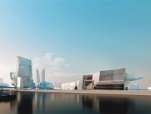The Unity of Opposites

In the rapidly developing city of Changsha (China), in the near future will appear a new grand cultural and arts complex, which its creators from the Austrian based Hans Hollein & Partner office named Meixihu (“Changsha Meixi Lake International Culture & Art Centre”).
A grand urban development unfolds around Meixi Lake incorporating a carefully conceived mix of functions nerved generously with waterways, underground traffic roads and boulevards. In a prime position, overlooking the waters and the ceremony island, the “Changsha Meixi Lake International Culture & Art Centre” will become the largest multifunctional world class culture and art centre of international standing in Hunan province. It will include an art center with a youth theater and museum, shopping mall, office and hotel towers.
Idea
While designing, the project creators primarily followed the logistics of the site, the forces around, the will to integrate or to counter the urban setting. This is the rational side of it. As always and everywhere there is the other side, which has to do with emotion and feelings, this being the artistic side which shapes the volumes in a sculptural way. The layout of the combined site – commercial and cultural – is developed as an integrated sculptural composition – yet each of the two components can exist independently although they support each other. The grand theatre and art gallery are to be conceived as individual buildings each, yet they form a sculptural unity within the townscape.
The auxiliary commercial services facilities within the site area to the west would support the culture and art centre enforcing its architectural standing among so many high-rise buildings. The mix of culture and commerce should also increase the feasibility of the project. On the Westside the commercial facilities are located: Three high-rise buildings to the south facing the view to the lake, the Ceremonial Island and the old town, behind in the north the big shopping center formed like a mound and split by a crevice where our pedestrian route goes through winding and splitting up – the route leads into a wide open landscaped area which it traverses, passing an artificial pond bordered by an open arena-like arrangement with its stage in the water.
The design should consider the relationship between the cultural and the commercial buildings and create a visual connection. Both shall be novel, creative and distinctive with the aim to make the project a world-class known landmark. Local traditional materials and approaches should combine with high technology and modern techniques of building and create a unique appearance considering the different functions of the museum and the theatre, the perception of the appearance should emphasize both unity and identity.
Full version you can download here
 Materials provided by Hans Hollein & Partner
Materials provided by Hans Hollein & Partner


